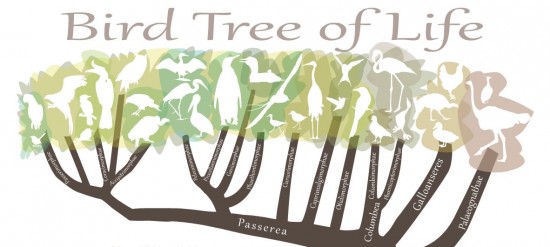In this past week, as the annual Christmas Bird Count began, what’s called the Avian Phylogenomics Consortium – 200 scientists, 80 institutions, 20 countries – began releasing its first results on nothing less than the origins of birds. This consortium has worked for the past four years on the whole genome sequencing of 48 bird species. Their results – which are expected to change the way we think about bird diversity – are being reported nearly simultaneously in 23 journal papers. Eight papers can be found in a December 12, 2014 special issue of the journal Science. Another 15 papers appear in the journals Genome Biology, GigaScience and other journals.
Overall, these works represent a landmark study on the origins of bird species, in which evolutionary biologists have made discoveries about the age of birds, and the genomic relationships among modern birds. We knew, for example, that today’s birds emerged and evolved after the mass extinction that wiped out dinosaurs and almost everything else 66 million years ago. We knew that the birds that survived the mass extinction experienced a rapid burst of evolution, sometimes called the ‘Big Bang’ of bird evolution.
But the spectacular biodiversity today’s birds – more than 10,000 species – was not well understood. Basically, scientists want to know how birds came to be so diverse.
A press release from the National Science Foundation, which helped fund the studies, explained:
To resolve these fundamental questions, a consortium led by Guojie Zhang of the National Genebank at BGI in China and the University of Copenhagen; neuroscientist Erich Jarvis of Duke University and the Howard Hughes Medical Institute; and M. Thomas P. Gilbert of the Natural History Museum of Denmark has sequenced, assembled and compared the full genomes of 48 bird species.
The species include the crow, duck, falcon, parakeet, crane, ibis, woodpecker, eagle and others, representing all major branches of modern birds.
These researchers now say they have been able to answer many fundamental questions “on an unprecedented scale.” Erich Jarvis commented:
This is an exciting moment. Lots of fundamental questions now can be resolved with more genomic data from a broader sampling. I got into this project because of my interest in birds as a model for vocal learning and speech production in humans, and it has opened up some amazing new vistas on brain evolution.
Watch the video above to learn of some of the early findings of the Avian Phylogenomics Consortium, or follow the links below.
Read more about the ‘Big Bang’ of bird evolution from the National Science Foundation
More results from the new work by the Avian Phylogenomics Consortium:
Sure, songbirds and other birds sprang from dinosaurs, too. But new work indicates that chickens and turkeys are genetically closest to their dino ancestors. Read more: Chickens and turkeys closer to dinos than other birds
Humans and vocal birds like parrots use essentially the same genes to speak. Read more: Genes link birdsong and human speech
A new study looks at how birds localize sounds. It seems that their slightly oval-shaped heads transform sound waves in a similar way to external ears. Read more: How birds get by without external ears

Bottom line: An international consortium of 200 scientists has release its first results on the origins of birds, expected to change the way we think about today’s winged rulers of the skies.











